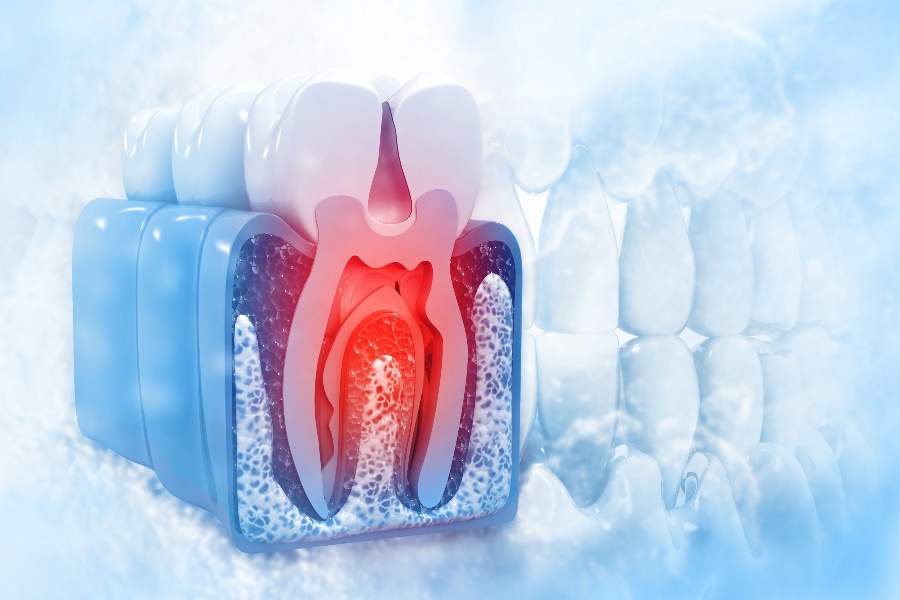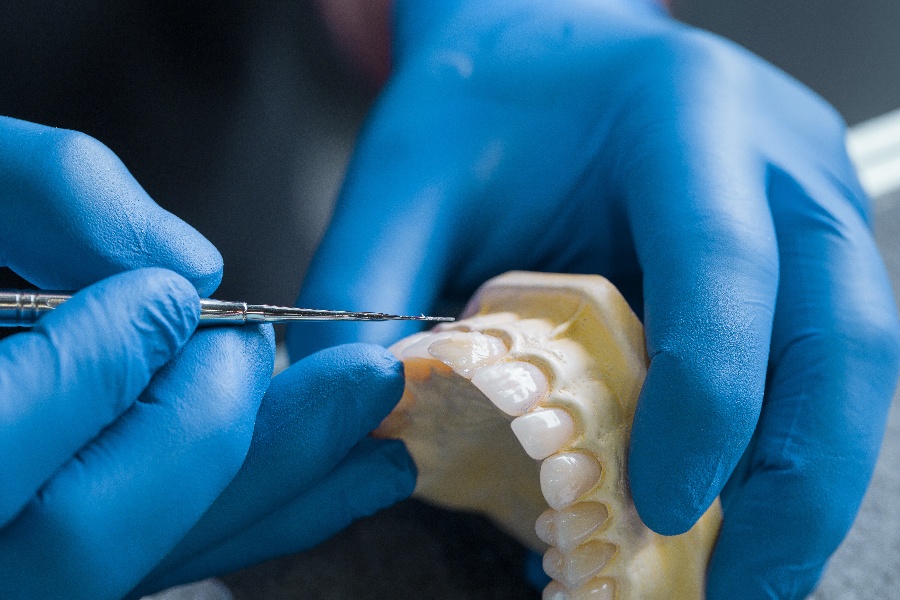Modern procedures, such as dental implants, allow dentists to replace missing teeth with natural-appearing dental crowns with a high degree of success. However, when you have the option, you may want to consider the nine benefits listed below of saving a natural tooth with a root canal treatment.
What Is Root Canal Treatment?
The technical term for root canal treatment is endodontic therapy. This dental procedure treats a damaged or infected dental pulp within a tooth. The dental pulp is a soft tissue that contains nerves, blood vessels, and connective tissue, which are essential for the development and growth of a tooth.
When the dental pulp becomes infected, it can cause severe pain and discomfort and may eventually lead to tooth loss. Root canal treatment is a highly effective way to remove the infected or damaged dental pulp and save the natural tooth.
What Causes An Infected or Inflamed Tooth?
Inflamed teeth can often be treated with fillings, bonding, or crowns if diagnosed early. However, infected teeth require a root canal treatment to save the natural tooth. There are several possible causes of an inflamed or infected dental pulp, including the following:
- Tooth decay. Tooth decay is one of the leading causes of an infected or inflamed tooth. When bacteria build up on the surface of a tooth, they can produce acid, leading to a cavity. If left untreated, the cavity can progress to the dental pulp, causing inflammation and infection.
- Trauma or injury. A tooth can become inflamed or infected due to trauma while playing sports, an automobile accident, or falling. The force of the trauma can lead to pulp damage, or the injury can break the tooth and expose the pulp to your oral environment, which leads to bacterial contamination of the soft bone tissue.
- Gum disease. Gum disease is a bacterial infection that affects the gums and bone surrounding teeth. When the disease is left untreated, the bacteria can spread to the dental pulp, causing infection and inflammation.
- Cracked tooth. A tooth that is cracked or fractured can allow bacteria to enter the dental pulp and cause infection and inflammation.
- Large fillings. Large fillings can weaken your tooth and make it more susceptible to fracture and dental pulp damage.
- Repeated dental work. Repeated dental work on a tooth, such as multiple fillings or crowns, can irritate the dental pulp and cause inflammation that leads to an infected or abscessed tooth.
- Excessive grinding or clenching. People who grind or clench their teeth excessively can damage tooth enamel, cause cracks in teeth, and eventually damage the dental pulp.
Symptoms Of A Tooth Needing Root Canal Therapy
You can have an infected tooth without any symptoms. Your dentist can typically identify this during a regular exam. However, you may also have a wide range of symptoms that indicate you need root canal therapy. These include:
- Sensitivity to hot or cold temperatures. If you experience sharp, sudden pain when you eat or drink something hot or cold, this may indicate an infected or inflamed tooth. If the sensitivity persists after the hot or cold stimulus has been removed, you should contact your dentist for an evaluation as soon as possible.
- Severe tooth pain. Pain is one of the most common symptoms of an infected or inflamed tooth that needs a root canal. The pain may be spontaneous, constant, throbbing, or sharp, and it may increase when you bite or chew. The pain may also radiate to the jaw, ear, or other areas of your head and neck.
- Swollen or tender gums. An infected or inflamed tooth can cause the gums around the affected area to become swollen, red, and tender. The swelling may be localized to the gums or spread to other areas of your jaw, mouth, and face.
- Discoloration of the tooth. If the affected tooth appears darker or grayer than the surrounding teeth, it may be a sign of an infection or inflammation of the dental pulp. This is common for teeth involved in trauma.
- Pimple or abscess on the gum. An abscess is a pocket of pus that forms around the tooth. This can cause a pimple or bump to appear on the gum near the affected tooth.
- Bad breath or a bad taste in the mouth. An infected tooth can produce an unpleasant odor or taste in the mouth that persists even after brushing your teeth or using mouthwash.
- Loose tooth. An infected pulp can cause the surrounding bone to weaken and loosen your tooth.
- Headache or earache. In some cases, an infected or inflamed tooth can cause headaches or refer pain to the ear.
- Fever. A fever may occur if the infection spreads beyond the tooth and into the surrounding jaw and soft tissues.
What Are The Steps To A Root Canal Procedure?
The root canal treatment procedure involves several steps that may take one or more visits. These steps include:
- Administration of local anesthesia to numb the tooth and surrounding area.
- Creation of a small opening in the tooth to access the infected or damaged dental pulp.
- Removal of the infected or damaged dental pulp using specialized dental instruments.
- Cleaning and shaping of the root canals to remove any remaining bacteria and debris.
- Filling the root canals with a biocompatible material to seal the tooth and prevent further infection.
- Placement of a temporary filling or crown to protect the tooth until a permanent restoration can be placed.
Advancements in root canal treatment technology, such as digital imaging, magnification and illumination, and rotary instrumentation, have made the procedure more successful, efficient, and comfortable. By understanding the root canal treatment procedure better, you can feel more at ease and confident in your decision to save your natural teeth.
The Nine Benefits Of Saving A Natural Tooth With A Root Canal Treatment
Rather than removing a natural tooth with a damaged dental pulp, root canal treatment aims to save the tooth and restore it to its full function. Here are nine benefits of saving a natural tooth with root canal treatment:
- Preserves bone structure. When a tooth is extracted, the underlying bone begins to deteriorate. By saving a natural tooth with root canal treatment, the tooth root is left intact, helping to preserve the bone structure in the jaw. This can prevent problems with surrounding teeth.
- Less invasive. Root canal treatment is a minimally invasive procedure that preserves the natural tooth while typically requiring only a small hole to be made in the tooth to access the infected or inflamed pulp.
- Restores normal biting force. A tooth that has undergone root canal treatment can usually withstand normal biting force, making it easier to eat a variety of foods and maintain excellent nutrition.
- Maintains natural appearance. A natural tooth is usually the best option for maintaining a healthy and attractive smile. Root canal treatment preserves the natural tooth and gums with minimal treatment.
- Prevents further damage. An infected or inflamed tooth can lead to serious dental problems if left untreated. By saving the natural tooth with root canal treatment, you can prevent further damage to surrounding teeth, gums, and bone.
- Cost-effective. Root canal treatment is usually less expensive than removing the tooth and replacing it with a dental implant or bridge. It is also typically covered by dental insurance.
- Quick and easy. Root canal treatment can usually be completed in just one or two office visits, making it a quick and convenient treatment option.
- Long-lasting results. With proper care, a tooth that has undergone root canal treatment can last for many years, if not a lifetime.
- Improves overall health. A healthy mouth is essential for overall health and well-being. By saving a natural tooth with root canal treatment, you can maintain good oral health and prevent the spread of infection to other parts of the body.
Schedule an Appointment
To learn more about the general and cosmetic dentistry services offered at Palmetto Dental Arts, call us or contact us online.




